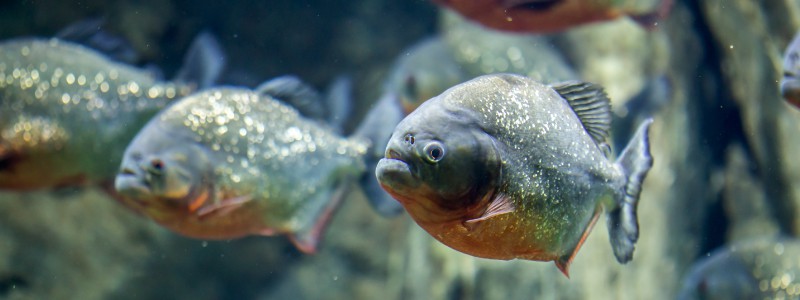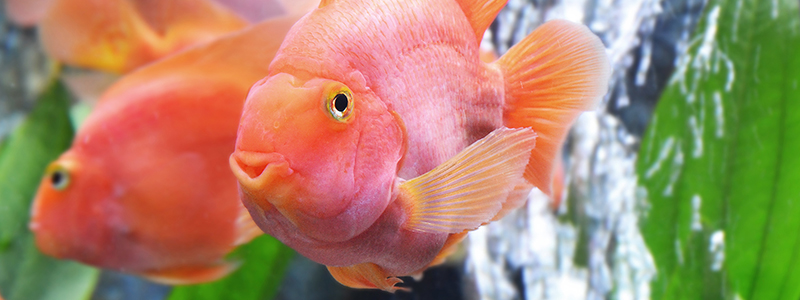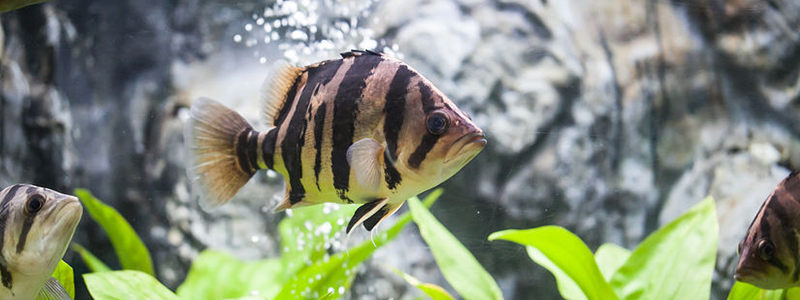Quick Overview
- Family: Characidae
- Scientific Name: Pygocentrus nattereri
- Care level: Diligent
- Temperament: Dangerously aggressive
- Diet: Omnivore
- Water conditions: Freshwater, Tropical (71.5°F to 82.5°F), pH 5.5 – 8.0
- Max Size: 12 to 24 inches, depending on tank size
- Minimum tank size (as an adult): 25 gallons for one, the larger the better
Overview: Piranha Care
Many people are intrigued by the idea of keeping a dangerous carnivore as part of their fishkeeping hobby. In reality, while it can be very rewarding, it’s not for everybody. In fact, it’s important to note that these fish are not legal throughout the United States. Concerns about their release into waterways where they would not reside naturally have prompted laws against keeping them as pets in many countries and several states. It’s easy to check with online resources to see if you are allowed to have piranha in your state and if you need a permit to keep them. https://www.opefe.com/state_stat_prohibit.html
Let’s proceed with the assumption that you’re allowed to keep piranha where you live and with the assumption that you’re interested in having a healthy, exciting pet that can present a real drama in your household. The most common type of piranha available in many parts of the United States is the red-bellied piranha, although you may also find a black, or red-eyed piranha. And, while they usually eat other fish, they are actually not carnivores, but omnivores – so some vegetation is good for them as well.
The best place to get a piranha is from someone who needs one taken off of their hands. A friend may find one getting outsized in a tank of several, or maybe ready to give up the hobby. If a diligent owner offers you a healthy pet and you’re ready for the commitment, get your environment for your own personal nature show.
A piranha – and it’s usually one – requires a large tank. At least 25 gallons, but 30 is better. They are freshwater river fish from South America, so a horizontal tank with a strong current helps them thrive. You may also choose to keep a second tank – for the fish you use to feed this hungry predator.
Most of the day, your piranha will swim silently against the current, but introduce another fish into their territory, and prepare to watch the show. Be quiet, be patient, and, if your piranha is completely comfortable, you will see it strike with great power and purpose. A brief scene, just like one from your favorite nature show, will take place right in your home.
If you witness this show of strength, you will quickly understand the respect this kind of pet demands. The power is awesome, and it’s also dangerous. Fingers cannot go into the tank. Not yours, not your guests. This is not the kind of pet for homes with children nor for a location where you do not have complete control over what happens to the tank. Only take on this kind of pet if you can take on this kind of responsibility.

Piranha Appearance
What size are piranhas when they’re small?
Piranha hatch from eggs attached to grasses and plant stems. Juvenile piranha can be purchased as small as 2 to 4 inches.
How fast/slow should you expect piranhas to grow?
They will grow quickly to double that size and then grow slowly and substantially until they reach the capacity of the tank. The impressive growth of a piranha may not be in its side measurements as much as in its girth. Unlike many of the relatively flat tropical aquarium fish, a piranha will take on width as it grows.
What’s piranha’s maximum size?
Most piranha in captivity will easily grow to 10 or 12 inches and in texts, it’s said they can reach 24 inches and 9 pounds. It would take a long time for a piranha to reach this size – and that’s possible – people report them living 10 – 20 years in captivity.
Different types of Piranha
- Red-bellied piranha
- Black piranha, also known as redeye piranha
A healthy red-bellied piranha is silver-grey with darker spots. Some are a brownish grey with darker spots. The anal fins can be spotted. As the name suggests, they have a bright red patch on the front belly, sometimes with red pectoral and pelvic fins as well. The females tend to have a brighter red color.
Piranha Diet & Feeding
What do Piranha eat?
Red-bellied piranha are omnivorous but most commonly feed on other fish. They will eat small amounts of fresh produce such as small pieces of zucchini or spinach. When young, they will eat small worms or shrimp you can purchase at a freshwater aquarium store. Even as adults you can feed them frozen prawns or crabs.
They will not eat commercial fish foods, such as flakes or pellets.
You may also choose to feed them other fish – usually one each day.
Piranha Feeding habits
Piranha will feed on other fish. This is one of the most intriguing parts of keeping them as a pet. If you drop another fish, such as a goldfish, into the tank it will likely remain oblivious to the imminent threat. When ready, the piranha will nonchalantly put itself in an attack position. This could be after a few minutes or a few hours. If you are quiet and patient, you can see it strike decisively and aggressively. A smaller fish may be taken in a few quick bites. A piranha does not chew, it will bite and swallow. It will take a grape-sized bite from larger prey, rendering it incapable of protecting itself or swimming away. It will then return to devour it in large gulps.
What food(s) are recommended for piranhas?
Most people who keep piranha as pets will choose to keep a separate tank of “feeder” fish. It’s popular to maintain a population of goldfish and feed them regularly to the piranha. Some will choose a tank of guppies or another easily bred fish to serve as nutrition for this aggressive carnivore. It’s best to keep a healthy, clean, and well-filtered tank for the food source because any issues in the feeder fish will be transferred to the piranha. Ich, flukes, and other parasites can be introduced to your piranha by their prey. Here is some great food for your piranha fish!
Most people who keep piranha as pets will choose to keep a separate tank of “feeder” fish. It’s popular to maintain a population of goldfish and feed them regularly to the piranha. Some will choose a tank of guppies or another easily bred fish to serve as nutrition for this aggressive carnivore. It’s best to keep a healthy, clean, and well-filtered tank for the food source because any issues in the feeder fish will be transferred to the piranha. Ich, flukes, and other parasites can be introduced to your piranha by their prey.
Piranhas are not fussy about their diet so you can feed them a wide variety of live, frozen, or ready-made fish meals. Many breeders avoid live fish as food due to the increased risk of contamination or infections. Frozen fishes, poultry meat, worms, and shrimp make an excellent meal for your piranhas with close to no health risks. Pellet foods are highly recommended as they provide the daily nutrients needed plus it doesn’t break your wallet.
Piranha Tank Setup
A brief overview of natural habitat
Piranha are freshwater river fish of South America. They thrive in a clean tank with a healthy current to swim against. They are relatively timid and enjoy partial hiding places and soft lighting. You may find them choosing a corner of the tank and spending most of their time there until the prey is introduced to the environment.
Piranha Tank size
Most texts recommend at least 25 gallons for a single piranha. They thrive in 30 gallons or more. They swim in schools in the wild, so they will tolerate other piranhas. It’s best to add another 10 gallons for each additional fish. People have success with four piranhas in a 60-gallon tank (30+10+10+10).
If you choose to keep more than one piranha, it’s imperative that you keep them sufficiently fed. While they may arrange themselves in a school and appear friendly, they are just as likely to see each other as prey. If they are threatened or hungry, you can easily lose one or more of your pets.
Water conditions (Temp., pH, KH)
Piranha requires clean freshwater kept at tropical temperatures. If you feed them other fish, you will need powerful filtration and frequent maintenance to keep the tank clean. Use a heater to maintain the temperature from 71.5°F to 82.5°F. Your pH should be between 5.5 and 8.0. Consider keeping all of the equipment external to the tank because the violent attacks of the piranha can cause breakage.
Decorations
Piranha enjoys a hiding place, but because they tend to remain stationary, you do not want to give them a place to completely stay out of view. They seem perfectly happy in a place where they are partially obscured by rocks or plants – either natural or artificial. Piranha may damage live plants but many owners have success with hornwort, javamoss, and ferns.
While a partial hiding place may make your piranha more comfortable, it’s important to give them free and open swimming lanes. Your fish needs the opportunity to strike at prey without hindrance, so keep these opportunities in mind when you arrange your tank.
Soft lighting can also help your piranha feel comfortable and still give you ample opportunity to see your fish and all of its impressive behavior.
Piranha Tank Mates
General Behavior
Piranha are content to find a quiet corner of a freshwater tank and swim there against a current, constantly monitoring their environment. They will sense anything that is introduced to the water and likely perceive it as prey. Any change will put them on high alert. If they feel threatened or if they determine that there’s a feeding opportunity, they will be ready to attack.
Piranha are aggressive predators. They are most often kept alone in a tank. If you have a large enough tank, you can keep multiple piranhas of the same size. They will definitely attack and eat each other, so it’s imperative that they are similar sizes. If one begins to dominate the tank, any other piranha are in danger.
A happy piranha will show bright colors and clear skin and eyes.
You may see your piranha chomp its mouth repeatedly. This is a sign of hunger.
With multiple piranhas in a tank, you may witness other behaviors. Circling the tank or wagging tails repeatedly is generally a sign of displeasure. It’s difficult to identify if your piranha is getting ready to breed or getting ready to fight. If they are biting each other’s fins, it’s likely to lead to a fight.
What fish can be kept in the same tank?
Some people report successfully maintaining a tank with other aggressive fish or bottom feeders. They report success with large catfish or a Plecostomus that stays out of the way. If you introduce one of these that survive in the same tank, do not be surprised if it remains hidden most, if not all, of the time. The other possibility is another aggressive South American fish, such as a red-bellied pacu.

How to Keep Piranha Healthy
Tips on keeping Piranha in good health
The best way to keep a piranha healthy is to maintain a clean tank and environment, for both the piranha and the fish you feed it. As mentioned earlier, any diseases in the feeder fish will be transferred to the piranha. Ich, flukes, and other parasites can be introduced to your piranha by their prey. Maintain a healthy tank for your smaller fish and destroy any unhealthy specimens before they infect your fish.
The aggressive feeding style creates a great deal of waste. A powerful filtration system, regularly maintained, is essential to good health. Regular water changes are a benefit as well. You must keep any bits of flesh or waste from breaking down in the gravel or substrate.
Breeding Piranhas
Because piranha are solitary fish, it’s unusual to successfully breed them. One would need a very large tank to keep multiple fish of both sexes happy. Breeding is best left to zoos and large breeders. But, it’s not impossible. If you keep multiple piranhas and you notice them turning black it’s a sign that breeding is imminent. If you keep live plants in your tank, you may find nesting behaviors and eggs laid amongst the stems.
Interesting Facts About Piranhas
Piranha have a notorious reputation for killing large mammals and even humans. Many horror films help to maintain this myth. This is not true. That being said, piranha are very dangerous fish to keep. They will bite. They have very powerful jaws. They have razor-sharp teeth. It’s possible for a piranha to significantly injure you. Imagine a grape-sized bite out of your hand.
Is a Piranha right for you?
After you’ve determined that it’s legal for you to keep a piranha where you live, you must be sure you’re committed to caring for a solitary fish in a large tank. You must know you can maintain a clean and well-filtered environment for a long time. Maybe a very long time. As far as freshwater aquarium fish go, it’s one of the most exciting specimens to keep. It brings natural drama and excitement. You can witness the raw power of nature’s fury every time you feed it. If you are patient, you can have a little scene out of Nat Geo in your home every night. But it also requires great responsibility. You must protect yourself and everyone in your home from its bite. And you must protect this amazing pet from disease and trauma. If you decide this is the right pet for you, best wishes to your new housemate.





